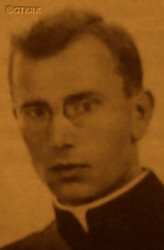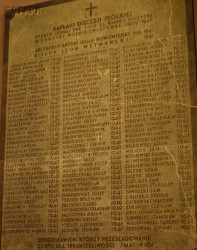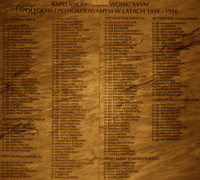Roman Catholic
St Sigismund parish
05-507 Słomczyn
85 Wiślana Str.
Konstancin deanery
Warsaw archdiocese, Poland
full list:
displayClick to display full list

searchClick to search full list by categories
wyświetlKliknij by wyświetlić pełną listę po polsku

szukajKliknij by przeszukać listę wg kategorii po polsku

Martyrology of the clergy — Poland
XX century (1914 – 1989)
personal data
surname
ŻURAWSKI
surname
versions/aliases
ŻÓRAWSKI
forename(s)
Ceslav (pl. Czesław)
function
diocesan priest
creed
Latin (Roman Catholic) Church RCmore on
en.wikipedia.org
[access: 2014.09.21]
diocese / province
Płock diocesemore on
en.wikipedia.org
[access: 2013.05.19]
Siedlce diocesemore on
en.wikipedia.org
[access: 2022.01.06]
RC Military Ordinariate of Polandmore on
en.wikipedia.org
[access: 2014.12.20]
date and place
of death
09.1939

(Volyn territory)today: Ukraine
more on
en.wikipedia.org
[access: 2022.08.05]
alt. dates and places
of death
04.1940, 05.1940, 06.1940, 1940
NKVD MinskHQ at 17 Sovetskaya Str.
today: 17 Independence Str., Minsk dist., Minsk city reg., Belarus
more on
en.wikipedia.org
[access: 2025.02.17]
Vilniustoday: Vilnius city dist., Vilnius Cou., Lithuania
more on
en.wikipedia.org
[access: 2022.01.06]
details of death
On 01.01.1939 nominated chaplain of the Polish Army reserve (during war time).
In 08.1939 mobilised and drafted.
After German invasion of Poland on 01.09.1939 and start of the World War II escaping from German offensive went to Pułtusk and then to Warsaw.
On 06.09.1939 moved to Siedlce where go vicar nomination for Siedlce diocese.
Next moved to Turów (Radzyń county) and from there towards Terespol.
Further fate uncertain.
Might have moved towards Lviv and next to Volyn where his brother was a policeman.
There Russian invasion of Poland on 17.09.1939 prob. caught up with him.
Apprehended by Russians soldiers and prob. taken to a nearby forest and murdered (the shots were heard).
alt. details of death
According to other sources mobilised in 08.1939 as the chaplain of the military investigative arrest in Vilnius. Arrested by the Russians in 1939/1940. According to one version, murdered in 04‐06.1940 as part of the «Katyn genocide», prob. in Minsk, as one of the victims of the still unknown so‐called «Belarusian Katyn list», and his body was buried in the Kuropaty forest.
According to other version murdered in Vilnius.
cause of death
murder
perpetrators
Russians
sites and events
NKVD MinskClick to display the description, KurapatyClick to display the description, Ribbentrop‐MolotovClick to display the description, Pius XI's encyclicalsClick to display the description
date and place
of birth
09.06.1906Birth certification on:
metryki.genealodzy.pl
[access: 2025.03.01]

Elżbiecintoday: Krasne‐Elżbiecin, Krasne gm., Przasnysz pov., Masovia voiv., Poland
more on
en.wikipedia.org
[access: 2021.12.18]
parents
ŻURAWSKI Casimir
🞲 ?, ? — 🕆 ?, ?

WALERYCH Anne
🞲 ?, ? — 🕆 ?, ?
baptism
15.06.1906Birth certification on:
metryki.genealodzy.pl
[access: 2025.03.01]

Węgrzynowotoday: Płoniawy‐Bramura gm., Maków Mazowiecki pov., Masovia voiv., Poland
more on
en.wikipedia.org
[access: 2021.12.18]
Holy Spirit RC church
presbyter (holy orders)
ordination
19.06.1932

Płocktoday: Płock city pov., Masovia voiv., Poland
more on
en.wikipedia.org
[access: 2021.12.18]
Assumption of the Blessed Virgin Mary RC cathedral churchmore on
en.wikipedia.org
[access: 2025.03.14]
positions held
1936 – 1939
vicar — Maków Mazowieckitoday: Maków Mazowiecki urban gm., Maków Mazowiecki pov., Masovia voiv., Poland
more on
en.wikipedia.org
[access: 2021.08.06] ⋄ Corpus Christi RC church ⋄ St Joseph RC parish ⋄ Maków Mazowieckitoday: Maków Mazowiecki urban gm., Maków Mazowiecki pov., Masovia voiv., Poland
more on
en.wikipedia.org
[access: 2021.08.06] RC deanery
1932 – 1936
vicar — Różantoday: Różań gm., Maków Mazowiecki pov., Masovia voiv., Poland
more on
en.wikipedia.org
[access: 2021.12.18] ⋄ St Anne RC parish ⋄ Maków Mazowieckitoday: Maków Mazowiecki urban gm., Maków Mazowiecki pov., Masovia voiv., Poland
more on
en.wikipedia.org
[access: 2021.08.06] RC deanery
till 1932
student — Płocktoday: Płock city pov., Masovia voiv., Poland
more on
en.wikipedia.org
[access: 2021.12.18] ⋄ philosophy and theology, Theological Seminary
others related
in death
CIEŚLAClick to display biography Felix, JASTRZĘBSKIClick to display biography Stanislav, KUREKClick to display biography Stanislav, MALINOWSKIClick to display biography Clement, STANISŁAWSKIClick to display biography Steven Thaddeus, SZCZERBICKIClick to display biography Fabian, SZUMOWSKIClick to display biography Marian Richard, ŻYLIŃSKIClick to display biography Boleslav
sites and events
descriptions
NKVD Minsk: In 04‐05.1940, the Russian genocidal NKVD organization shot in Belarus — as part of the «Katyn genocide of 1940» — c. 3,870 Poles (according to some assumptions, there could have been as many as 4,465). This genocide was the implementation of the decision of the Russian Commie‐Nazi authorities — the Politburo of the Russian Commie‐Nazi party — of 05.03.1940 to exterminate tens of thousands of Polish intelligentsia and servicemen held in Russian camps, established after the German‐Russian Ribbentrop‐Molotov Agreement and the annexation of half of Poland by the Russians in 1939. After the formal „verdict”, the NKVD Special Council in Moscow, i.e. the genocidal Russian kangaroo court known as the «NKVD Troika» sent disposition letters to the NKVD in Belarus, containing the names of people to be murdered. In order to implement this, the head of the NKVD, Lavrentiy Beria, issued on 22.03.1940 order No. 00350 on the „unloading of NKVD prisons”, ordering the transport of convicts from several smaller prisons in Belarus to Minsk. The given number of victims — 3,870 — is a number calculated on the basis of a handwritten note by Alexander Shelepin, then head of the Russian KGB, who wrote on 03.03.1959 that in 1940 7,305 Poles were executed from camps and prisons in Ukraine and Belarus; and on the basis of the so‐called «Ukrainian Katyn List» («Cvetukhin list») of 25.11.1940, containing 3,435 names of people murdered in Ukraine. The aforementioned disposition lists are not known — it is not even known how many there were: from other known such lists of the «Katyn genocide» it can be concluded that there were at least 9 of them, and probably many times more. Therefore, the people who were murdered are not known. Among them were prob. many of the 1,996 people known by name, transported in early 1940 from NKVD prisons in Belarus to Minsk, including from Brest (c. 1,500 people), Pinsk (c. 500), Baranavychi (c. 450), although not all of them. The victims were prob. murdered in Minsk, Belarus, in the internal prison of the Belarusian NKVD headquarters at 17 Sovetskaya Str. (today 17 Independence Street) or in the nearby prison known as „Vołodarka”, in the Pishchalauski Castle at Volodarsky Street, in soundproof basements, one by one, by the so‐called Katyn method, with a pistol shot to the back of the head. The bodies were mostly buried in pits in the Kuropaty forest near Minsk. To this day, neither the Russians nor the Belarusians have released detailed protocols of this genocide in their possession. (more on: en.wikipedia.orgClick to attempt to display webpage
[access: 2025.02.18])
Kurapaty: Forest near Minsk in Belarus, where mass graves of victims murdered by the Russian genocidal NKVD organization in the years 1937—1941 were discovered. It is also the place where these murders were carried out — in addition to human remains, shell casings and bullets were also discovered there. The NKVD genociders brought there, in closed cars, convicts and shot them there. Murders were also carried out in other places in Minsk, including prob. of Poles — as part of the «Katyn Genocide 1940», and their bodies were supposedly buried in Kurapaty. Estimates of the number of murdered range from 7,000 (the version of the Prosecutor General of Belarus) to 250,000 or even more. For decades, the Belarusian authorities have been sabotaging efforts to thoroughly investigate the site of the genocide. The archives are classified. In school textbooks published in Belarus after 2000 there is not a word about Kurapaty. (more on: en.wikipedia.orgClick to attempt to display webpage
[access: 2023.01.18])
Ribbentrop‐Molotov: Genocidal Russian‐German alliance pact between Russian leader Joseph Stalin and German leader Adolf Hitler signed on 23.08.1939 in Moscow by respective foreign ministers, Mr. Vyacheslav Molotov for Russia and Joachim von Ribbentrop for Germany. The pact sanctioned and was the direct cause of joint Russian and German invasion of Poland and the outbreak of the World War II in 09.1939. In a political sense, the pact was an attempt to restore the status quo ante before 1914, with one exception, namely the „commercial” exchange of the so‐called „Kingdom of Poland”, which in 1914 was part of the Russian Empire, fore Eastern Galicia (today's western Ukraine), in 1914 belonging to the Austro‐Hungarian Empire. Galicia, including Lviv, was to be taken over by the Russians, the „Kingdom of Poland” — under the name of the General Governorate — Germany. The resultant „war was one of the greatest calamities and dramas of humanity in history, for two atheistic and anti‐Christian ideologies — national and international socialism — rejected God and His fifth Decalogue commandment: Thou shall not kill!” (Abp Stanislav Gądecki, 01.09.2019). The decisions taken — backed up by the betrayal of the formal allies of Poland, France and Germany, which on 12.09.1939, at a joint conference in Abbeville, decided not to provide aid to attacked Poland and not to take military action against Germany (a clear breach of treaty obligations with Poland) — were on 28.09.1939 slightly altered and made more precise when a treaty on „German‐Russian boundaries and friendship” was agreed by the same murderous signatories. One of its findings was establishment of spheres of influence in Central and Eastern Europe and in consequence IV partition of Poland. In one of its secret annexes agreed, that: „the Signatories will not tolerate on its respective territories any Polish propaganda that affects the territory of the other Side. On their respective territories they will suppress all such propaganda and inform each other of the measures taken to accomplish it”. The agreements resulted in a series of meeting between two genocidal organization representing both sides — German Gestapo and Russian NKVD when coordination of efforts to exterminate Polish intelligentsia and Polish leading classes (in Germany called «Intelligenzaktion», in Russia took the form of Katyń massacres) where discussed. Resulted in deaths of hundreds of thousands of Polish intelligentsia, including thousands of priests presented here, and tens of millions of ordinary people,. The results of this Russian‐German pact lasted till 1989 and are still in evidence even today. (more on: en.wikipedia.orgClick to attempt to display webpage
[access: 2015.09.30])
Pius XI's encyclicals: Facing the creation of two totalitarian systems in Europe, which seemed to compete with each other, though there were more similarities than contradictions between them, Pope Pius XI issued in 03.1937 (within 5 days) two encyclicals. In the „Mit brennender Sorge” (Eng. „With Burning Concern”) published on 14.03.1938, condemned the national socialism prevailing in Germany. The Pope wrote: „Whoever, following the old Germanic‐pre‐Christian beliefs, puts various impersonal fate in the place of a personal God, denies the wisdom of God and Providence […], whoever exalts earthly values: race or nation, or state, or state system, representatives of state power or other fundamental values of human society, […] and makes them the highest standard of all values, including religious ones, and idolizes them, this one […] is far from true faith in God and from a worldview corresponding to such faith”. On 19.03.1937, published „Divini Redemptoris” (Eng. „Divine Redeemer”), in which criticized Russian communism, dialectical materialism and the class struggle theory. The Pope wrote: „Communism deprives man of freedom, and therefore the spiritual basis of all life norms. It deprives the human person of all his dignity and any moral support with which he could resist the onslaught of blind passions […] This is the new gospel that Bolshevik and godless communism preaches as a message of salvation and redemption of humanity”… Pius XI demanded that the established human law be subjected to the natural law of God , recommended the implementation of the ideal of a Christian state and society, and called on Catholics to resist. Two years later, National Socialist Germany and Communist Russia came together and started World War II. (more on: www.vatican.vaClick to attempt to display webpage
[access: 2023.05.28], www.vatican.vaClick to attempt to display webpage
[access: 2023.05.28])
sources
personal:
sw.gov.plClick to attempt to display webpage
[access: 2015.09.30], metryki.genealodzy.plClick to attempt to display webpage
[access: 2025.03.01], www.ordynariat.wp.mil.plClick to attempt to display webpage
[access: 2012.12.28]
bibliographical:
„Płock diocese clergy martyrology during II World War 1939‐1945”, Fr Nicholas Marian Grzybowski, Włocławek–Płock 2002
„Martyrology of the Polish Roman Catholic clergy under nazi occupation in 1939‐1945”, Victor Jacewicz, John Woś, vol. I‐V, Warsaw Theological Academy, 1977‐1981
original images:
www.katedrapolowa.plClick to attempt to display webpage
[access: 2014.01.16]
LETTER to CUSTODIAN/ADMINISTRATOR
If you have an Email client on your communicator/computer — such as Mozilla Thunderbird, Windows Mail or Microsoft Outlook, described at WikipediaPatrz:
en.wikipedia.org, among others — try the link below, please:
LETTER to CUSTODIAN/ADMINISTRATORClick and try to call your own Email client
If however you do not run such a client or the above link is not active please send an email to the Custodian/Administrator using your account — in your customary email/correspondence engine — at the following address:

giving the following as the subject:
MARTYROLOGY: ŻURAWSKI Ceslav
To return to the biography press below:
 Click to return to biography
Click to return to biography











